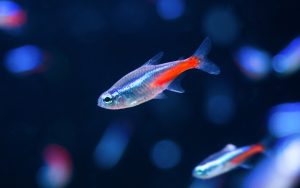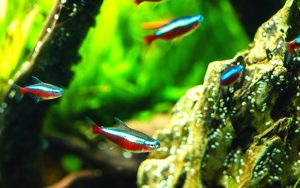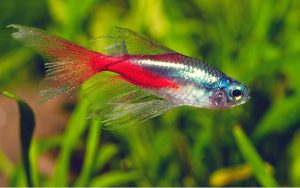Guppies are among the most popular and beloved aquatic creatures, but do you know how big do guppies get? While guppies may be small when purchased, they have the potential to grow and reach a substantial size depending on their environment.
Guppies or rainbow fish, also known as million fish, are popular for the home aquarium hobby, but many new aquarists need to know what size tank they should get for them.
Not getting the right guppy tank size can lead to stunted growth, disease, and even death of your guppies.
This means you’ve wasted your money and risked your pet’s health. Don’t take the risk!
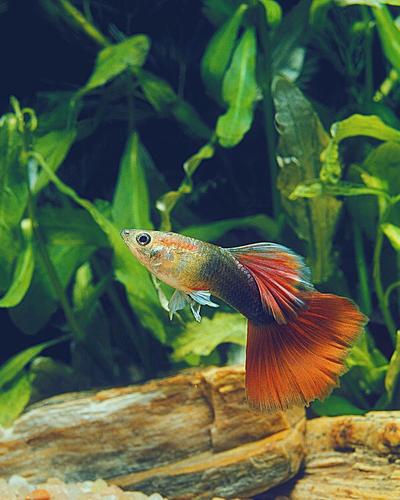
This blog post will discuss how big can a guppies get in an aquarium and what factors influence the fish’s growth process.
We will also explain why some people may keep smaller tank inhabitants like guppies instead of larger fish species. Keep reading to learn more about guppy growth patterns!
Table of Contents
ToggleHow Big Does Guppies Get?
How big do guppy fish get? Guppies typically grow up to 0.6-1.4 inches for males and 1.2-2.4 inches for females. However, the size of a guppy can be affected by several factors, such as nutritional intake, age, and genetic factors.
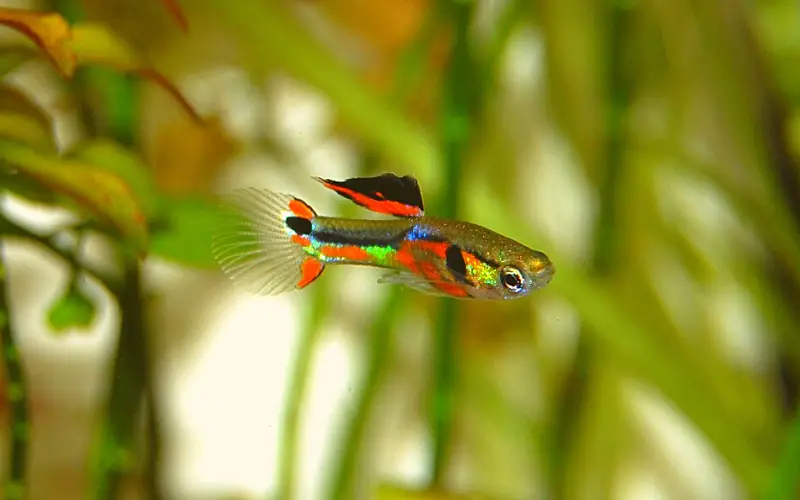
The older a guppy is, the larger it will usually become as it matures over time. Additionally, providing your fish with proper nutrition is essential to ensure they have enough energy to grow to their full potential.
How Long Does It Take for a Guppy to Grow to Full Size?
How big can guppies get? It takes about six months for a guppy to reach its full size. The growth rate of a guppy depends on the water’s temperature and the quality of food and nutrients it receives.
If temperatures are cool (20°C or less) and conditions are ideal, adult guppies’ size can be reached in only four months. On average, expect your guppies to reach their full-grown size between 6-8 months old.
What Size Tank Do You Need for Guppies?
Guppies are best kept in tanks of 10 gallons or larger. The minimum guppy tank size will depend on how many guppies you plan to keep, so factor in that number when choosing a tank.
If you plan to keep a small school of guppies, you should get at least 20 gallons or larger. If you keep a larger group, getting a community tank of at least 30 gallons is best.
A larger tank will provide your guppies with more space to swim and explore, and it will help maintain a healthier environment for them.
How Many Guppies Do You Need?
Guppies are best kept in groups of 3-5, with a ratio of one male to two or three female guppies. Keeping too many guppies in one tank can damage the water quality and stress the fish.
Regarding guppies, it’s important to remember that less is more. Too many guppies in one tank can lead to stress and disease, so make sure to find the right balance for your tank.
How Many Guppies Can Be in a 10-Gallon Tank?
Generally, five to six guppies can be comfortably kept in a 10-gallon tank. Be sure the tank has plenty of caves and hiding spots so that all fish have a safe place to retreat when needed.
Additionally, plenty of water plants and decorations provide stimulation for the guppies. It’s also important to note that depending on the size of your guppy, you may need to adjust the number you keep in a 10-gallon tank accordingly.
How Big Do Male Guppies Get?
On average, male guppies reach a full size of 1.5-1.8 inches in length. They can, however, grow up to 2 or even 3 inches in length, depending on the environment they are living in and their diet.
To ensure your guppy grows to its maximum potential size, provide them with high-quality food such as flakes or plankton pellets specially formulated for healthy growth and plenty of space and places to hide from predators.
How Big Do Guppies Get When Pregnant?
Female guppies grow to be between two and three inches long when pregnant. During their gestation period, the dorsal fin of a female guppy will become noticeably bigger and more pronounced as her body prepares for motherhood.
Furthermore, the abdomen of a pregnant female guppy may also appear swollen with eggs that are ready to be hatched. After giving birth to her fry, the female will return to her original size within about four weeks.
Common Reasons Why Guppies Stop Growing
Guppy fish is regarded as being the least cost-effective tropical fish. The fish keepers get in the habit of putting guppy fish into the community tanks. Guppy fish enjoy water sports, so buy an extra large aquarium.
Tanks should have at least five gals (22.9 liters) capacity, which the industry considers standard size. Tanks have a capacity of up to 10 kg (45.4 liters).
Spacious aquariums are more effective at increasing growth and help the animals to reach maximum size at optimal levels. The aquarium is large enough for them to enjoy the swimming space. The sex of the man and his wife. Some guppy fish varieties are textured with metallic materials.
What Factors Affect the Growth Rate of a Guppy?
The development of the guppy depends upon many variables, including water conditions, fish tank dimensions, gene expression, and tankmate diet. But a small amount of growth can cause them to slowly grow without achieving their full heights.
Here are some of the most important factors that can affect a guppy’s growth rate:
– Lack Of Nutrition
Guppies are hungry and love to eat healthy meals. It is necessary to have a balanced diet that includes both dry and whole food for healthy development.
– Genetics
It has a genetic component in guppy growth. Generally, two guppies will have very little growth in their lives. The fish’s tail and fin color is also derived from genetics. Guppy breeders can mix with their mates to produce bigger babies.
– Tank Conditions
It may be problematic if your water tank has fewer rocks, sand, or plants. It is possible for guppies that less space can be used for movement and growth. In addition, adult guppy tanks can become too dirty, resulting in stunting growth.
– Aquarium Size
A tank will never have enough space because the guppies are tiny. They have enough time to swim, hide, and allow themselves to develop. If you have space shortages within larger tanks, you could separate pregnant guppy into separate breeding tanks.
This is important to keep the endler guppies protected and helps save space. Guppy fish tanks require approximately 30-gallon tanks for 10 – 15 fish. But there must be enough room for fries when it comes to breeding.
How Long Do Guppies Live?
What Is the Lifespan of a Guppy? The average life span of guppies is two to three years if cared for properly.
Guppy lifespan can be extended by providing optimal living conditions, including a clean and spacious tank, high-quality nutrition, regular water changes, and proper temperature regulation.
They tend to live longer when kept in larger groups as this encourages natural behaviors such as swimming and socializing in the safety of their shoal.
Additionally, providing hiding places like caves or plants will help reduce stress levels and encourage them to stay active.
How Fast Do Guppies Grow?
At What Age Do Guppies Reach Their Maximum Size? Guppies are fast growers with good nutrition, reaching their full size in six months. In the wild, guppies typically reach maturity around 4-6 months after birth, depending on environmental factors and resources available.
In aquariums that are kept at optimal temperatures and fed regularly with high-quality food, guppies will reach sexual maturity even faster. They grow by 0.25 inches (0.64 cm) each month up to a maximum size of 1 inch (2.5 cm).
This growth rate is much faster than many other species of fish in the same family, making them popular choices for aquarists looking to populate a guppy tank or pond with interesting fish quickly.
How Can You Speed Up Guppy Growth?
You can stimulate guppies by regulating water intake and diet. There is no magic method to this if guppy genetic traits are intended to be smaller than expected, as there’s no need for food.
Can feeder guppy fish grow larger in the right conditions? It usually happens fast, but you must consider the following things:
– Ensure Optimum Water Parameters
Guppy fry grow significantly more efficiently with the best conditions in water parameters. To achieve this, it is essential to ensure everything works well — including pH, temperature, and air quality.
Since baby guppies must be fed four times a day, the water quickly gets dirty. Therefore it’s important to change water more frequently.
Nitrites and ammonia quickly accumulate and can inhibit growth and be deadly. I suggest at least three small water changes of 20-30 percent each week.
– Adequate Tank Space
The large tank provides enough space for adult Guppy forage, swimming, courting, and explore to promote health and happy living. Eventually, this enables their growth relatively rapidly.
Generally speaking, the dogs require 2-4 gallons a day. The average fry will require half a gallon of water. The aquarium’s large population causes overpopulation, and it is the most likely source of the need for more aquarium space.
Aside from that, it’s important to get rid of all kinds of stuff in tanks, like plants or exhibit pieces.
– Separate the Fry Stage Guppies
Let fries develop independently to mature children. This gives babies the space to swim, float and grow. Separating them into separate breeding tanks is essential to prevent crowded tanks and resource competition.
With larger tanks, you could separate pregnant female guppies from the general population and keep them in their tanks until they give birth and their babies grow up.
– Guppies Diet & Feeding
Guppies need a balanced diet to grow fast and healthy. The baby guppies must be fed 4-5 times daily with dry or frozen foods or live foods like Baby brine shrimp, daphnia, or microforms. This helps guppies to grow faster and stronger.
It also helps create healthy eating habits to ensure optimal growth. Do not overfeed them, which could lead to stunted development and death. Avoid using too much flake food, as this could cause digestive problems.
By following these steps, you can ensure your guppies have the best chance of growing to their full potential. They can reach their maximum size within six months and live a long and healthy life with proper care.
How Big Does Guppy Fry Get?
Guppy fry, or baby guppies, typically grow to an average size of ¼” when born. After that, it depends on the care and environment you provide for them; proper nutrition is essential for any young fish species.
Guppies can reach a maximum length of about 2 inches in adulthood if given the ideal conditions. Ideally, these small freshwater fish should be kept in tanks of at least 20 gallons or more, so they have plenty of room to swim and lack overcrowding which could lead to their stunted growth.
Guppy Growth Stages: (Guppy Size by Age)
Guppies are livebearers, so they produce life-size fry. Guppies are often married to females. After a guppie fends off a female guppie, it grows in swathes. Approximately a month passes before a fry is born.
Afterward, guppy fry develops and progresses into adulthood. Below is a list of the different growth stages a Guppy fry will undergo before becoming an adult.
- Birth: Fry is born at a maximum length of ¼”.
- 2 Weeks Old: Guppy fry has grown to ½” in length.
- 4 Weeks Old: Guppy fry has grown to ¾” in length.
- 8 Weeks Old: At this point, guppy fry is close to the adult guppies’ size of 1 ½”.
- 6 Months Old: Fully grown guppies reach a maximum size of 2″ in length.
Young Adult Guppies Stage
At the young adult stage, a young guppy was sexually active. They might look for partners to partner with as soon as possible. You can separate the male and the female guppies if there are fewer guppies in the aquarium.
A separated population also aids in healthy growth as guppies eat more fish food and do not mate. Currently, the person has to make some modifications to their diet.
This could help if we cut our fat intake so they don’t suffer ill health. Give your pup some protein and some green food. Brine shrimp should always serve as the main source. Aside from this, the Spirulina and Planke pellets are designed with an attractive color.
Adult Stage
In six months, the guppie is a mature adult. Depending on their genetics, diet, and conditions, the sizes of guppies are between 1.5 and 2 inches (4 cm to 6 cm) tall. At that moment, your guppies have stopped.
However, guppies can grow in length depending on their genetics. Your puppy is growing and needs an extensive diet for its health. Generally speaking, Flake-Based Foods that are high in protein are good for guppies.
When Do Guppies Get Their Color?
It has been observed that guppies develop their full range of colors between 1 week and six weeks old. At this age, they will have an array of hues, patterns, and shades from which to choose.
This is when you’ll notice combinations like the classic blue and gold combo or the wilder orange with purple stripes. It’s amazing how small fish can contain so much variation!
How Much Do Juvenile Guppies Grow?
Juvenile guppy has an average height of 2 – 3 inches. In the young guppies’ stages, it grows very fast. It will also be interesting that the female guppies are slightly longer than the male guppies because they have genetic characteristics.
Your baby can differentiate between female and male guppy fish at a juvenile stage. They’re easily visible through strikingly diverse color combinations. Guppies have more vibrant colors than their female siblings.
Guppies have larger heads, but the color is somewhat duller. You may also notice gravid spots in piglets that are absent from guppies.
Do Fancy Guppies Need a Different Breeding Tank for Proper Growth?
Absolutely. Fancy guppies, like the one in the picture, have been bred over generations to develop stunning coloration and finnage (tail design).
Unlike their wild ancestors, these guppies require specialized selective breeding conditions to breed guppies and ensure they properly grow and maintain their unique features. This includes a separate tank with slightly acidic water to regulate pH, oxygen levels, and temperature.
Additionally, they should be provided with ample hiding places, such as plants or driftwood pieces, that provide accommodations and create spawning areas for them.
How to Breed Guppies for Size
Breeding guppies for size is a relatively simple process that can be done by both experienced and novice aquarists. The key to successful breeding is selecting the right pair of two guppies with desirable characteristics.
It’s important to select female and male guppies who are both healthy but also have the desired traits you would like in your offspring. To breed guppies for size, When selecting, look for males larger than females and ones with vibrant colors or patterns on their bodies.
It’s important to note that before putting together any pair of jumbo guppies, it’s essential to ensure they’re compatible by introducing them into separate tanks before combining them so they don’t fight each other when put together.
Once you’ve carefully selected your ideal couple, it’s time to move on to step two: setting up an environment suitable for breeding, including water temperature between 72-80 degrees Fahrenheit and neutral pH levels (7.0-7.8).
Add some hiding places, such as large rocks and plants; this will help them produce more fry since they feel safer when given sheltering areas away from predators or other fish in the tank.
Conclusion
So, how big do guppies get? Keeping guppies as pets can be a rewarding experience for both beginner and experienced aquarists. These fish come in various colors and fin styles and grow to an impressive size of about three inches when given the proper care and nutrition. Guppies are peaceful fish and can make interesting additions to established home aquariums.
However, before getting a guppy, ensure that any future tank mates have similar needs and water constraints. Guppies can live and thrive in many different bodies of water, so it’s important to familiarize yourself with all their requirements before purchasing one or more for your home aquarium. That way, you can ensure your guppy stays healthy and content in its new home! keep reading to find out how big does a guppy get?
You might also like
- How Long Does Guppy Live: 7 Easy Tips to Prolong Their Life
- Do Guppies Lay Eggs or Give Birth? (A Comprehensive Guide)
- How Many Guppies in a 10 Gallon Tank: (An Exclusive Guide)
- Can Guppies Breed with Mollies? Molly Guppy Hybrid (Solved)
- How Many Eggs Do Guppies Lay? An Essential Guide (Solved)
- How to Breed Guppies: A Comprehensive Guide (for Beginners)
- How Many Guppies in 20 Gallon tank? A Complete Guide
- Do Guppies Like Strong Current: 5 Shocking Reasons Why Yes!
- Male vs Female Guppies: 5 Proven Ways to Spot the Gender!
- Do All Guppies Eat Their Babies: (5 Reasons & Solutions)
- Hybrid Endler Guppy: 5 Mind-Blowing Facts You Need to Know!
- What Can Guppies Eat in the Wild: (A Comprehensive Guide)


